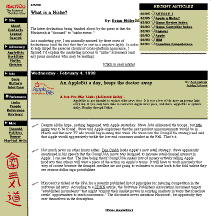Advocacy
Dojo (HowTo)
Reference
Markets
Museum
News
Other
![]()
Myths
Press
General
Hack
Hardware
Interface
Software
Standards
People
Forensics
Web
CodeNames
Easter Eggs
History
Innovation
Sightings
Opinion
Martial Arts
ITIL
Thought

![]()
|
 MacKiDo
rev-8
MacKiDo
rev-8
- up to July 4, 1998
OK. Big redesign.
I gave up on the graphical buttons. They were just taking too much time to load. Going back to text should literally reduce first time loads by about half.
Because neither Netscape nor Microsoft seem to care about the quality of their products, and JavaScript sometimes causes browsers to crash for no good reason, I decided to remove that as well. It didn't crash people often -- but often enough. So I did text-based topic-buttons again.
Because text on a textured pattern is hard to read, I removed the texture along the control strip. (I couldn't have a texture without having graphical buttons to hide them). But I decided to be more rigid on the color theme.
I replaced the graphics for the few QBullets that I used with my own (to keep in the color theme). The controls are now a bit more symbolic, but also less obtrusive and aesthetically pleasing. But they may change more.
I grouped buttons into sections to make them more clear (as to what they do) and because of the aesthetics. I added topics and information to the control strip (Again):
- Contact information should be obvious on a site -- as many were telling me. I figured that "About" was clear, but some people complained about having difficulty finding my email.
- Since I have some Martial Arts information (and may add more), I decided to create that section as well.
- I also have a lot of political emails and posts that I've done over time, so I might throw a few of those in there.
- I added a section on "Sites". Just to talk about running a web site, and web technology.
- I am going to a search button, but I probably won't be able to implement it on my current ISP. But I may move to self-hosting in the future, so I can hope.
But the biggest changes was in the HTML code itself. I'd been using a few meta-tags so that I could replace or add items to the control strip, or change banner ads. But I hadn't done that enough! I also hadn't done all the formatting in a "standard" way. This killed me, and made this update painful. There will be other articles explaining what I've learned. Suffice it to say, that I had to go through all the pages (500 of them), and make sure that all the tags were in place, and added many more, and am trying to standardize on how I use each tag (and color), and embed far more meta-tags, so that things can change in the future. This will be a big help and prepare me for new technologies like XML, DHTML, or CSS (Style Sheets).
In articles, I added a path to the top of the article -- this is so if people print out Articles, that it will guarantee that the URL is in there.
I also designed a table for going through series of articles on the same topic. However, I won't actually use that all at once, I will slowly add it, and fix some older series as time permits. I'm thinking of scripting this, or some way other than manually creating all those tables (which is painful).
This change not only makes things more consistent, and gives me more topic areas -- but it gives me a lot more capabilities to tune and refine the site in the future. Especially the Server Side Include technology that I used (and will explain in a separate article).
Lessons
- JavaScript sucks! (Now known as
DHTML) Avoid it as much as possible. Unfortunately it is
not always possible. But I'll explain this in detail in
another article.
- Keep grouping, and regrouping
things until it makes sense. Keep things navigable.
- Don't use technology for
technology sake (on a site) -- find where it will be
usefull, and what it can offer. If it can't cut the
mustard (so to speak), then abandon it, and stick with
what works. Don't be afraid to try new things -- but have
a purpose for them.
- Again, Metatags are important
-- especially for large sites. Use them!
- Server Side Includes are a
great technology.
- Keep making rules that simplify
behaviors -- and apply them. Refine, simplify. Keep
constistant.Time is progressing -- make sure your site is
too (and for the better).
- Remember to try your site on
multiple platforms and browsers! Things change.
- A sites value is based on its readers. That is what matters -- that people read the information and find it useful. If they find value, and keep coming back, then you are doing something right. Thanks to the readers for making this site what it is.
|